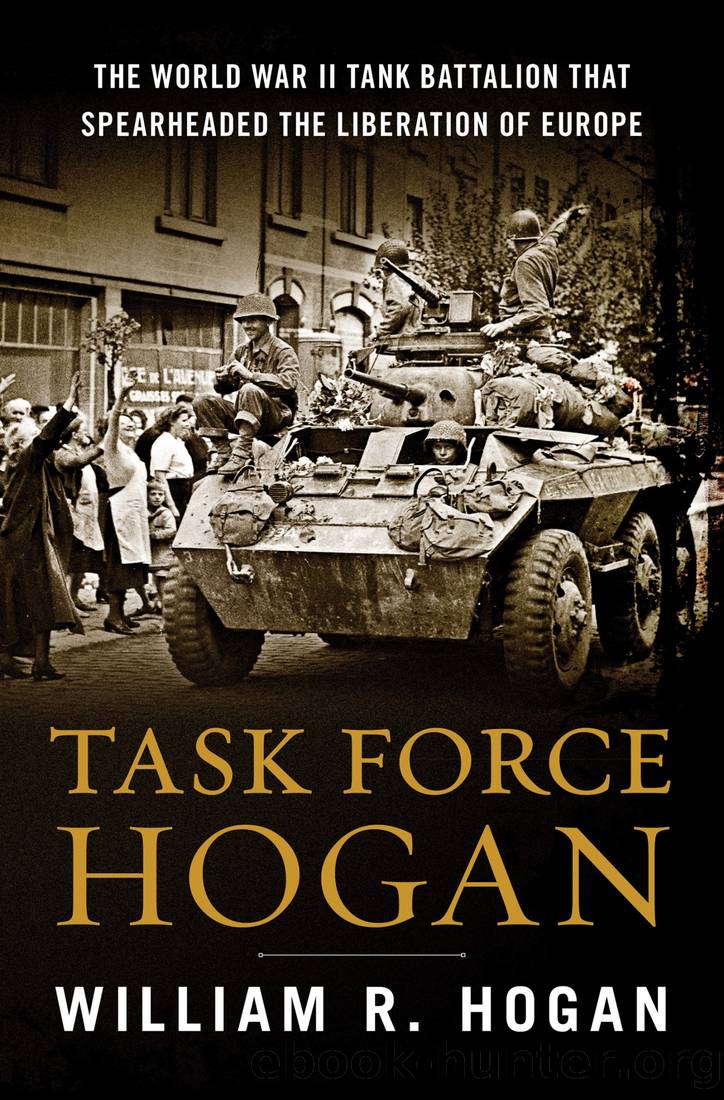Task Force Hogan by William R. Hogan

Author:William R. Hogan [Hogan, William R.]
Language: eng
Format: epub
Publisher: HarperCollins
Published: 2023-08-30T00:00:00+00:00
7
Not a Quiet Christmas
NOVEMBER 1âDECEMBER 22, 1944
The end of October and first half of November saw the Ruhr turn into a quagmire as persistent rains saturated the soil and grounded the Air Corps. German Landser and American GI settled into an uneasy standoff to Spearheadâs front. Before the Americans could even think of taking Cologne and its bridge across the Rhine, they needed to conquer a crossing on the tributary shielding it, the Roer. Third Armored Division units fought hard for every inch of ground, much of which was mined. The Germans then blew a dam on the Inde River, flooding the battle zone with up to five feet of water in some places. With the First and 104th Infantry Divisions also bogged down in the Hürtgen Forest, the stalemate held.
Frozen turkeys arrived at the front line ahead of Thanksgiving as Task Force Hogan paused to rest and refit after the grinding slog toward the Roer River. The objective of capturing Cologne was forgotten for the time, as the allies were forced to stockpile fuel and ammunition in preparation for the last big push. Units settled in for an expected quiet Christmas. The hope remained among some troops that the Germans might even surrender, that the GIs could still make it home for Christmas. But this soon proved overly optimistic.
The companies spread out around the recently liberated towns of Büsbach, Mausbach, and Stolberg. Soldiers kept to their roadblocks and occasionally exchanged gunfire with German patrols. The tense deadlock continued between the exhausted men and machines facing off under the low, gray clouds that portended a frigid winter.
On December 10, Task Force Hogan, with G Company in the lead and H Company in support, attacked the German town of Geich. From pillbox positions hidden within a barn and covered with hay, the Germans waited patiently for the advancing Americans to get in range. The platoon of tanks moved quickly but slowed down as alert tank commanders sighted the dark gray splotches of a minefield. âMinefield ahead, get ready for contactâover.â
The German gunners opened fire from two directions, tracers crossing toward the Sherman tanks. With a series of loud crunches, the well-emplaced mines covered by antitank fire took out five G company tanks in the space of minutes. Radio queries of âWhatâs going on, George element?â went unanswered as crews rapidly bailed out of smoking tanks. Miraculously, nobody was killed, but spalling fragments wounded Tech 5 Harold Stearns and Lieutenants Fred Matzenbacher and Robert Miller.1
Sam, situated between the two columns in his command tank, advanced to the sound of explosions and the last position of G Company. The radio traffic reported mine strikes ahead when, thirty seconds later, Sam felt a loud explosion and crash of metal but with no obvious penetration of the armor. The tank shuddered as driver Elmer Johnson attempted to steer, with no effect. Two mines ripped out both of the Shermanâs tank treads. Sam knew from experience that the explosion was not from an antitank gun.
He slowly
Download
This site does not store any files on its server. We only index and link to content provided by other sites. Please contact the content providers to delete copyright contents if any and email us, we'll remove relevant links or contents immediately.
| Afghan & Iraq Wars | American Civil War |
| American Revolution | Vietnam War |
| World War I | World War II |
Waking Up in Heaven: A True Story of Brokenness, Heaven, and Life Again by McVea Crystal & Tresniowski Alex(37676)
Empire of the Sikhs by Patwant Singh(22978)
We're Going to Need More Wine by Gabrielle Union(18972)
Hans Sturm: A Soldier's Odyssey on the Eastern Front by Gordon Williamson(18489)
Leonardo da Vinci by Walter Isaacson(13189)
The Radium Girls by Kate Moore(11930)
Tools of Titans by Timothy Ferriss(8224)
Educated by Tara Westover(7946)
How to Be a Bawse: A Guide to Conquering Life by Lilly Singh(7394)
Permanent Record by Edward Snowden(5743)
The Last Black Unicorn by Tiffany Haddish(5558)
The Rise and Fall of Senator Joe McCarthy by James Cross Giblin(5230)
Promise Me, Dad by Joe Biden(5088)
The Wind in My Hair by Masih Alinejad(5034)
A Higher Loyalty: Truth, Lies, and Leadership by James Comey(4851)
The Crown by Robert Lacey(4731)
The Iron Duke by The Iron Duke(4293)
Joan of Arc by Mary Gordon(4017)
Stalin by Stephen Kotkin(3883)
